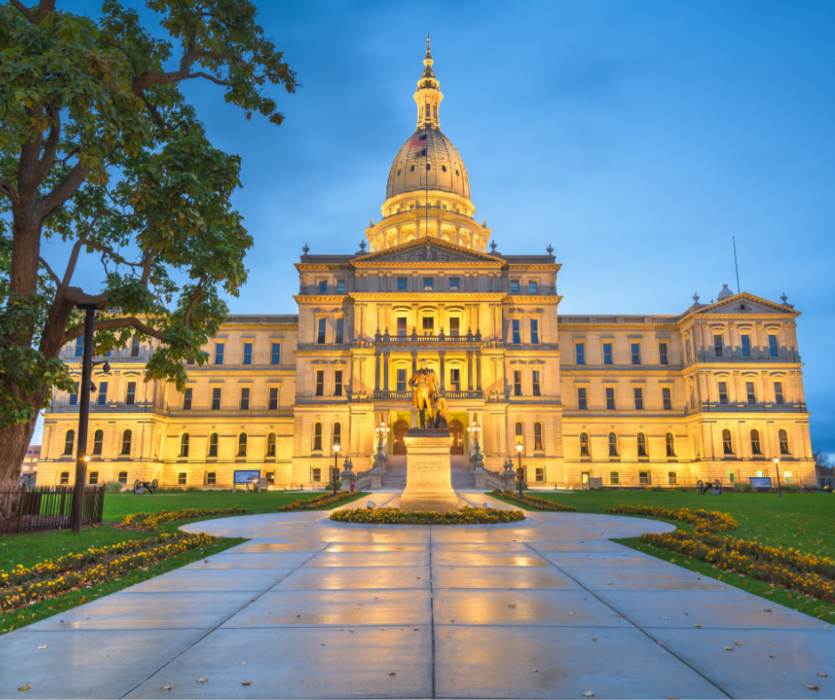
House and Senate leaders are meeting with Gov. Gretchen Whitmer’s office on how to spend what is now at least $15 billion in federal dollars and higher-than-expected state tax revenue before year’s end. As of Tuesday, COVID response and law enforcement is joining a growing underground water infrastructure wishlist at the top of the list.
Prior to Thanksgiving, Budget Director Chris Harkins sent lawmakers a $2.5 billion supplemental request that’s similar to a request from earlier in the year.
In the Whitmer administration’s eyes, the most critical spending item is $300.8 million for school safety programs to test and screen K-12 kids for coronavirus. The current funding is set to expire in Summer 2022 and the Budget Office wants to tap into this final money pot now to help school districts isolate cases more quickly. The last thing it wants is schools reducing in-person instructional days due to outbreaks.
House Appropriations Committee Chair Thomas Albert (R-Lowell) pointed out Tuesday that lawmakers have already appropriated $500 million in COVID testing money and there’s $210 million the administration is sitting on that hasn’t been spent.
He said he’s not pointing fingers, but just making the observation — “It takes time to go through it. It’s as simple as that. You can only spend money so quickly. It’s just the natural rate of how things get spent.”
Albert was asked if he’d be willing to put more money into funding the teacher shortage. He noted an overall workforce shortage in critical areas like health care and public safety.
“Simply throwing money at schools is not going to solve the teacher shortages we have,” Albert said. “We have got to find a way to get people back to work.”
Albert said as legislative leaders get comfortable with Harkins — the former Senate Fiscal Agency director and House Republican staffer — as the budget director, the goal has been to find areas of consensus and “check the boxes.”
On Wednesday, the House Appropriations Committee is prepared to kick out a $250 million supplemental that focuses on programs and equipment to help the law enforcement profession, highlighted by a $57.5 million incentive program designed to lure out-of-state cops to Michigan.
Over in the Senate, the price tag on its water infrastructure bill rose from $2.5 billion to $3.3 billion as the amount of the total lead line replacement programs grew from $600 million to an even $1 billion.
The Senate is using the new federal transportation money, not the COVID relief dollars, to pay for the programs. Other highlights of the spending bill are:
– $680 million for dam safety, of which $250 million is going to repair dams at four Midland County lakes
– $400 million to the Detroit water system for sewer and drinking water upgrades
– $15 million to assist Detroit residents with sewer connections and valve checks after flooding this past summer
The plan was to kick SB 565 out of the Senate Appropriations Committee on Wednesday to set up a Thursday floor vote.
Senate Appropriations Committee Chair Jim Stamas (R-Midland) said state government has been careful to “maximize” the roughly $15 billion coming to the state this year while abiding by the changing rules as opposed to quickly pushing out spending.
The key Senate Democratic negotiator reported he is “cautiously optimistic” about reaching an agreement with the Republicans on its various water-related projects, but he told MIRS he has not seen the actual language and until he does he remains “a six” on a 10-point scale on whether this eventually gets passed.
A veteran of many budget scrimmages, Sen. Curtis Hertel (D-East Lansing) explained, “politics has slowed down things in this place before” and while he is truly encouraged that both sides are finally talking about numbers, a final agreement is not there, yet. “It’s a good step in the right direction,” he said.
Local governments have been waiting all year for the state to unload the $10 billion or so in federal COVID recovery dollars and the Senator says it’s time to act.
“The state is sitting on billions of dollars that was sent here by the federal government to help us recover from the pandemic but those dollars are not out the door. This is a breakthrough that we’re actually going to start spending some of these dollars. That’s a good sign.”
MIRS previously reported that the Governor and the bi-partisan legislative leadership quadrant had agreed that Michigan’s aging, and in some cases, crumbling infrastructure, should get the bulk of the federal aid. “When we all agree on what the priorities are, it should make the negotiations much easier,” the Democratic vice chair of the Senate Appropriations Committee said.
His “six” turns into a 10 if all of this stuff falls into place by Christmas.